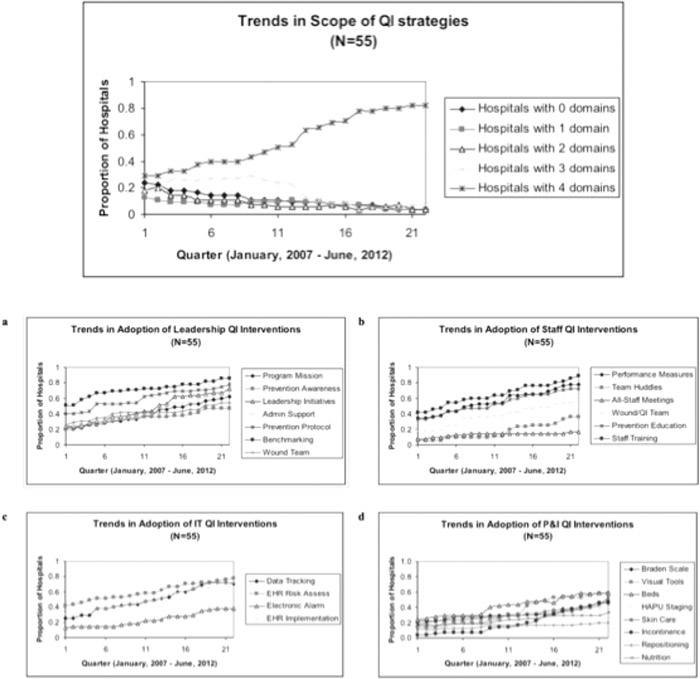Background:
In 2008, the Center for Medicare and Medicaid Services (CMS) enacted nonpayment policy for hospital‐acquired pressure ulcers (HAPUs). Hospitals responded to policy by increasing HAPU prevention efforts. To quantify adoption patterns of quality improvement (QI) interventions designed to support evidence‐based guidelines for HAPU prevention.
Methods:
We surveyed wound care nurses at University HealthSystem Consortium (UHC) hospitals to determine which QI interventions were included in HAPU prevention protocols. The validated questionnaire organized 29 HAPU‐specific QI interventions into four domains: Leadership; Staff; Information Technology (IT); and Performance & Improvement (P&I). Respondents checked QI interventions implemented anytime between 2007‐2012. Descriptive statistics evaluated patterns of QI adoption and t‐tests established statistically significant (p>0.05) increases in adoption. The points of time evaluated for QI adoption were 3rd‐quarter, 2008 when changes to CMS policy discontinued HAPU reimbursement, and 2nd‐quarter, 2012. Increases were described in terms of scope (number of QI domains employed) and scale (number of QI interventions within domains).
Results:
Fifty‐five (59%) UHC hospitals responded to the survey. Fifty‐three (96%) hospitals reported implementing QI with HAPU prevention. Leadership interventions were most frequent, increasing in scope from 40‐63% between 2008‐2012; scale increased significantly for all leadership interventions, with “annual programs to promote pressure ulcer prevention” showing the greatest increase. Staff interventions increased in scope from 32‐53%; signficant increases in scale occurred for six‐of‐seven interventions, with “frequent consult driven huddles” undergoing the greatest increase. IT interventions increased in scope from 31‐55%, and all five IT interventions increased significantly. Establishing an electronic HAPU trigger/alarm for high‐risk patients accounted for the greatest adoption. P&I interventions increased in scope from 18‐40%. Seven‐of‐nine P&I interventions had significant increases in scale, with “new skin care products…” increasing the most.
Conclusions:
UHC hospitals increased adoption of QI interventions, including scope and scale of QI strategies, since changes in CMS nonpayment policy to support HAPU prevention protocols and make use of novel technology and medical products. The next step in this research is to compare the effectiveness of different QI interventions.

